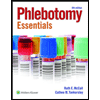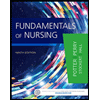
Phlebotomy Essentials
6th Edition
ISBN: 9781451194524
Author: Ruth McCall, Cathee M. Tankersley MT(ASCP)
Publisher: JONES+BARTLETT PUBLISHERS, INC.
expand_more
expand_more
format_list_bulleted
Question
The plasma concentration of a drug is 50 mg/L and is decreasing in first-order fashion with a half-life of 12 hours. Approximately how may hours will it take for the blood concentration to fall to a desired range of 10-15 mg/L?
(A) 12
(B) 24
(C) 36
(D) 48
(E) 50
Expert Solution
This question has been solved!
Explore an expertly crafted, step-by-step solution for a thorough understanding of key concepts.
This is a popular solution
Trending nowThis is a popular solution!
Step by stepSolved in 2 steps

Knowledge Booster
Similar questions
- Simvastatin 10MG Oral Tablet [Zocor] Generic name and popular Trade name(s) for this drug Drug classification What is this drug typically used for? Describe the pharmacokinetics of the drug: Onset (O) Peak (P) Duration (D) Half-life (1/2) Metabolized where (M) Excreted (E) Major side effect and/or Adverse Reactions of the drug? Nursing Implications (What do you need to assess, know or plan for with this medication?) Patient Education (What will you tell the patient and family about this drug? What do you need to teach the patient or family to safely take this medication)arrow_forwardIncreased blood pressure A) Epinephrine B) Isoproterenol C) Phenylephrine D) Physostigmine E) Tyramine Control Prazosin X Cocaine X Time 161. Drug X is injected intravenously into three subjects (including one control subject). The control subject is not pretreated, whereas the other two subjects are pretreated with either prazosin or cocaine. Blood pressure is recorded directly from the brachial artery (see graph). Drug X is most likely which of the following? 4 Xarrow_forwardChemistry The patient in the previous example received 1000 mg of an antibiotic every 6 hours byrepetitive IV injection. The drug has an apparent volume of distribution of 20 L and anelimination half-life of 3 hours. Calculate:(a) the plasma drug concentration, Cp at 3 hours after the second dose(b) the steady-state plasma drug concentration, Cpss at 3 hours after the last dose (c) Cpmax(d) Cpmin(e) Cpaverage.arrow_forward
- In order to understand the alpha and beta properties (mechanism of action) of Epinephrine, you 38) must be familiar with the drug's _______. A) Pharmacotherapeutics B) Pharmacodynamics C) Bioavailability D) Pharmacokineticsarrow_forward54. The volume of distribution of a drug is 350 L. Which of the following is most likely to account for this volume of distribution? OA) Extensive binding to tissue proteins B) Extensive hepatic metabolism C) Inability to cross the blood-brain barrier D) Low lipid solubility E) Rapid renal excretionarrow_forwardA 35 year old woman begins therapy with a drug( 50 mg twice daily) that has a volume distribution of 70L and an elimination half life of 2 days. According to first order kineticds, the average drug concentration will reach 75% of the average steady state blood concentration after how many days (A) 2 (B) 4 (C) 6 (D) 8 (E) 10arrow_forward
- 1) You have a loml vial of heparin which is labeled ee l0,50 units Im". You have with drawn 0.7ml of heparin In >> your Syringe How many units are Cont aired In this volume?arrow_forwardHeparin 25,000 units in 1000 mL of 0.9NS is ordered to infuse at a rate of 100 units per hour. How many mL/hr will be set on the infusion pump?arrow_forwardi found this past paper however i cannot find the solutions, please can you answer question 1barrow_forward
- For the next set of exercises, convert the given drug dilutions into milligrams per milliliter. 16. Given: Calculate: 17. Given: Calculate: 18. Given: Calculate: 19. Given: Calculate: 20. Given: Calculate: 21. Given: Calculate: 22. Given: Calculate: On hand: 1:25 dilution On hand: On hand: 1:100 dilution On hand: On hand: 1:80 dilution On hand: On hand: 1:50 dilution On hand: On hand: 1:625 dilution On hand: On hand: 1:333 dilution On hand: On hand: 1:500 dilution On hand: _mg/ml mg/ml _mg/ml _mg/ml _mg/ml _mg/ml _mg/mlarrow_forwardFirst, we will build a model for the total amount of drugs in the gut. At time \(t = 0\), \(10mg\) of the drug is present in the gut. From the gut, it passes slowly into the blood. The passage of the drug to the blood has first-order kinetics; that is, every hour \(42\%\) of the drug remaining in the gut is passed from the gut into the blood. No more pills are taken, so no extra drug is added to the gut. Let \(a_t\) be the sequence representing the amount of Adderall XR in the patient’s gut \(t\) hours after the pill was taken. Write down a recursion relation for \(a_t\). Find an explicit formula for \(a_t\). Calculate the time at which the amount of drug remaining in the gut drops to \(1\%\) of its starting value; that is, find \(t\) for which \[a_t = 0.01a_0\] Find \(\lim_{t\to\infty}a_t\), what does it represent? Now let’s build a model for the amount of drug in the patient’s blood. Define another sequence \(b_t\) that represents the amount of Adderall XR in the patient’s…arrow_forwardMrs. Johnson came into your clinic complaining of fatigue, feeling cold all the time, and unexplained weight gain. A blood test gives the following results (normal ranges given for comparison): T3: 0.03ng/dl (normal: 0.2-0.5 ng/dl) T4: 1.1 ug/dl (normal: 4-7 ug/dl) TSH: 86 mU/l (normal: 0.3-4.0 mU/l) A) Explain how you know the problem is with Mrs. Johnson’s thyroid and not her pituitary gland. B) Is Mrs. Johnson suffering from primary or secondary hypothyroidism? Explain your answer. you must explain the distinction between primary and secondary endocrine disorders and relate to this specific scenarioarrow_forward
arrow_back_ios
SEE MORE QUESTIONS
arrow_forward_ios
Recommended textbooks for you
 Phlebotomy EssentialsNursingISBN:9781451194524Author:Ruth McCall, Cathee M. Tankersley MT(ASCP)Publisher:JONES+BARTLETT PUBLISHERS, INC.
Phlebotomy EssentialsNursingISBN:9781451194524Author:Ruth McCall, Cathee M. Tankersley MT(ASCP)Publisher:JONES+BARTLETT PUBLISHERS, INC. Gould's Pathophysiology for the Health Profession...NursingISBN:9780323414425Author:Robert J Hubert BSPublisher:Saunders
Gould's Pathophysiology for the Health Profession...NursingISBN:9780323414425Author:Robert J Hubert BSPublisher:Saunders Fundamentals Of NursingNursingISBN:9781496362179Author:Taylor, Carol (carol R.), LYNN, Pamela (pamela Barbara), Bartlett, Jennifer L.Publisher:Wolters Kluwer,
Fundamentals Of NursingNursingISBN:9781496362179Author:Taylor, Carol (carol R.), LYNN, Pamela (pamela Barbara), Bartlett, Jennifer L.Publisher:Wolters Kluwer, Fundamentals of Nursing, 9eNursingISBN:9780323327404Author:Patricia A. Potter RN MSN PhD FAAN, Anne Griffin Perry RN EdD FAAN, Patricia Stockert RN BSN MS PhD, Amy Hall RN BSN MS PhD CNEPublisher:Elsevier Science
Fundamentals of Nursing, 9eNursingISBN:9780323327404Author:Patricia A. Potter RN MSN PhD FAAN, Anne Griffin Perry RN EdD FAAN, Patricia Stockert RN BSN MS PhD, Amy Hall RN BSN MS PhD CNEPublisher:Elsevier Science Study Guide for Gould's Pathophysiology for the H...NursingISBN:9780323414142Author:Hubert BS, Robert J; VanMeter PhD, Karin C.Publisher:Saunders
Study Guide for Gould's Pathophysiology for the H...NursingISBN:9780323414142Author:Hubert BS, Robert J; VanMeter PhD, Karin C.Publisher:Saunders Issues and Ethics in the Helping Professions (Min...NursingISBN:9781337406291Author:Gerald Corey, Marianne Schneider Corey, Cindy CoreyPublisher:Cengage Learning
Issues and Ethics in the Helping Professions (Min...NursingISBN:9781337406291Author:Gerald Corey, Marianne Schneider Corey, Cindy CoreyPublisher:Cengage Learning

Phlebotomy Essentials
Nursing
ISBN:9781451194524
Author:Ruth McCall, Cathee M. Tankersley MT(ASCP)
Publisher:JONES+BARTLETT PUBLISHERS, INC.

Gould's Pathophysiology for the Health Profession...
Nursing
ISBN:9780323414425
Author:Robert J Hubert BS
Publisher:Saunders

Fundamentals Of Nursing
Nursing
ISBN:9781496362179
Author:Taylor, Carol (carol R.), LYNN, Pamela (pamela Barbara), Bartlett, Jennifer L.
Publisher:Wolters Kluwer,

Fundamentals of Nursing, 9e
Nursing
ISBN:9780323327404
Author:Patricia A. Potter RN MSN PhD FAAN, Anne Griffin Perry RN EdD FAAN, Patricia Stockert RN BSN MS PhD, Amy Hall RN BSN MS PhD CNE
Publisher:Elsevier Science

Study Guide for Gould's Pathophysiology for the H...
Nursing
ISBN:9780323414142
Author:Hubert BS, Robert J; VanMeter PhD, Karin C.
Publisher:Saunders

Issues and Ethics in the Helping Professions (Min...
Nursing
ISBN:9781337406291
Author:Gerald Corey, Marianne Schneider Corey, Cindy Corey
Publisher:Cengage Learning